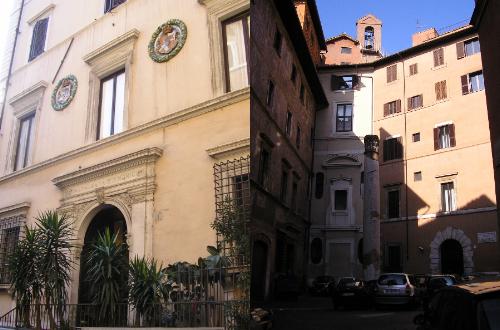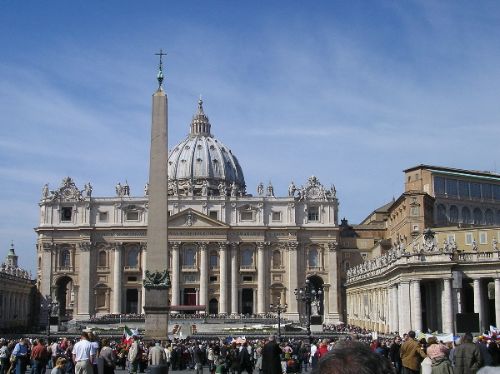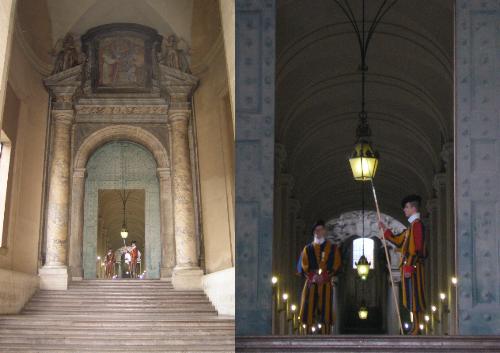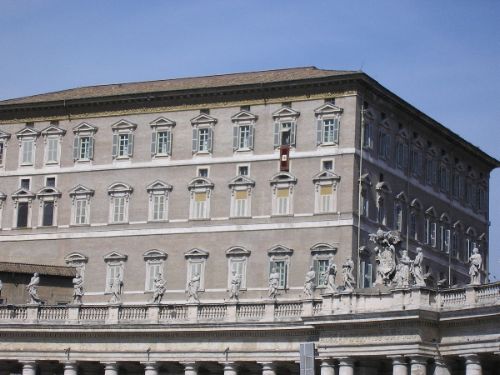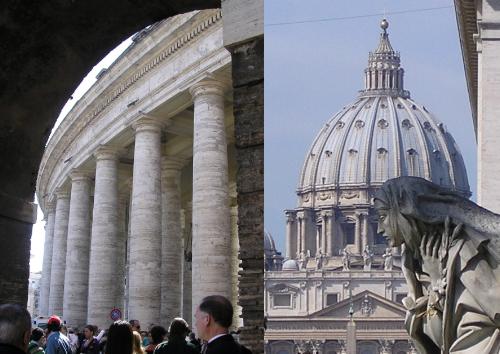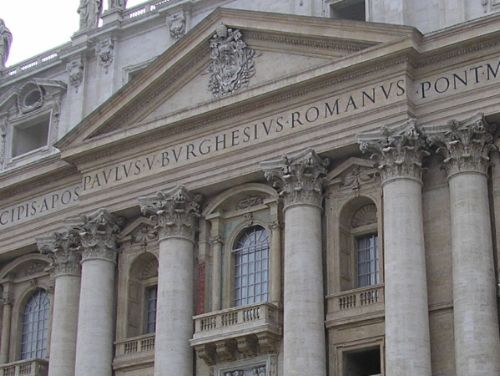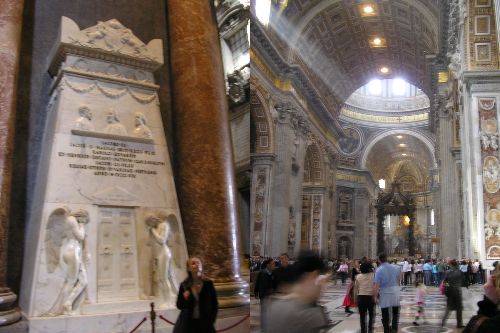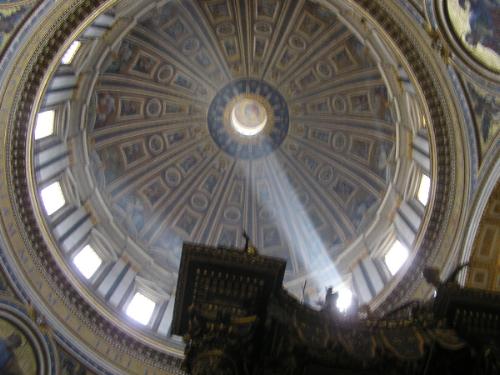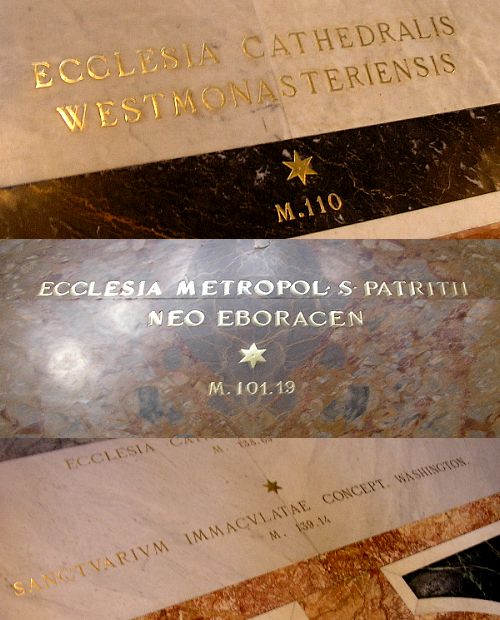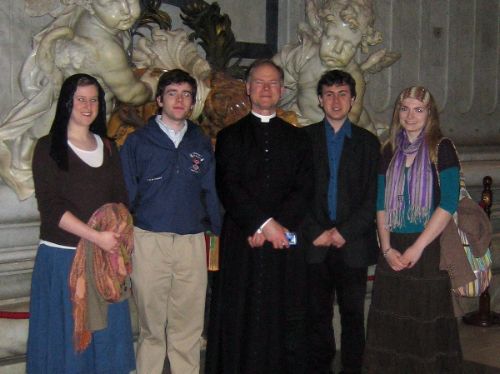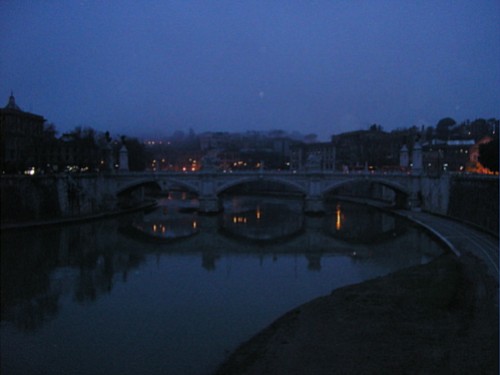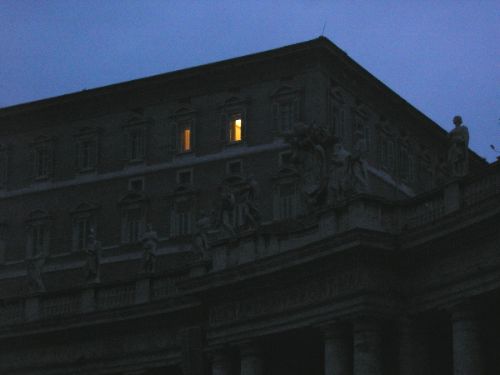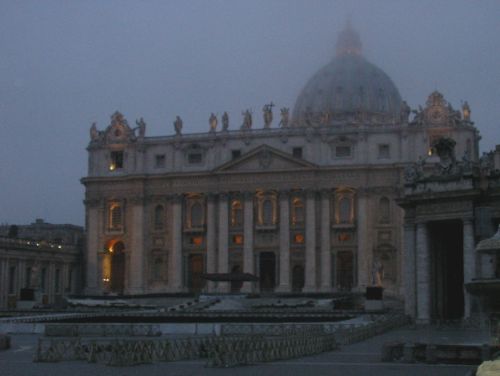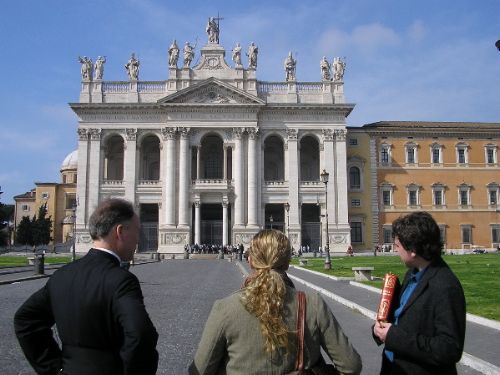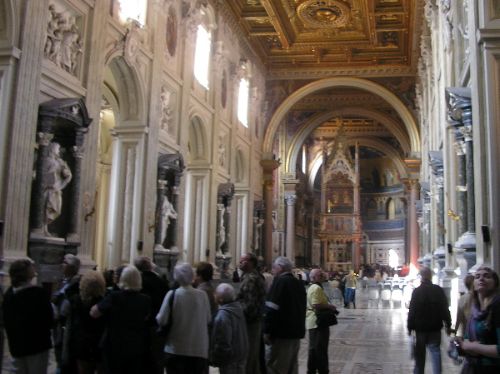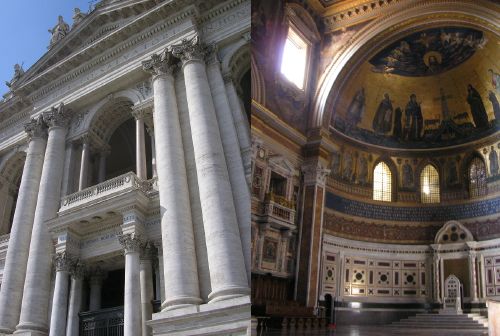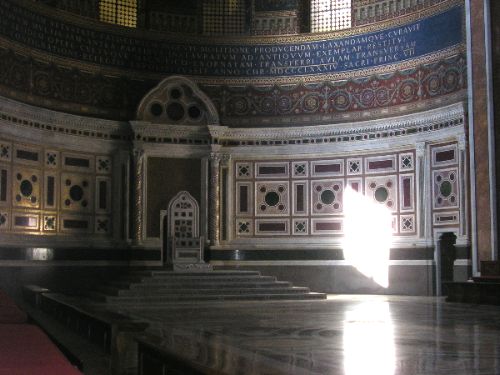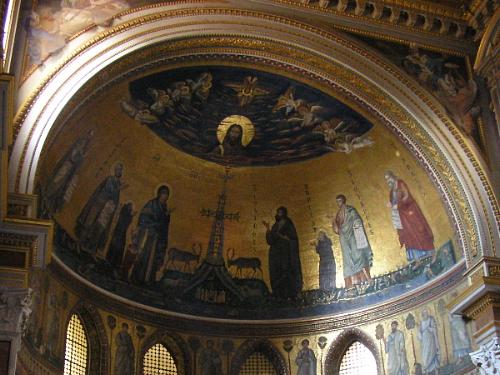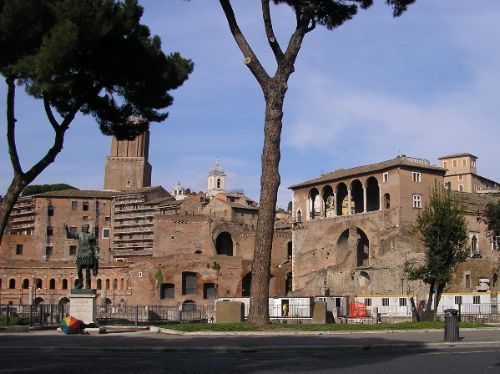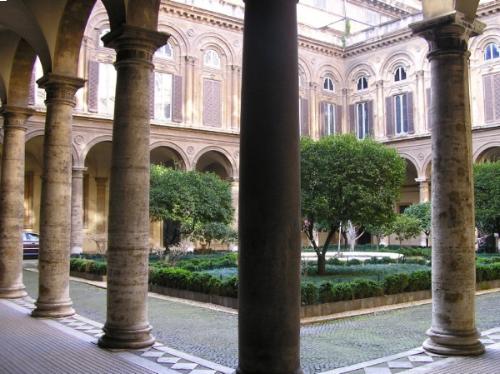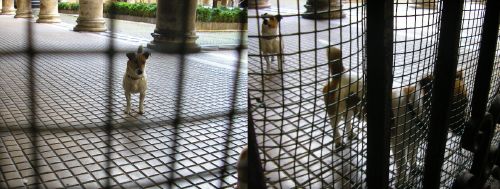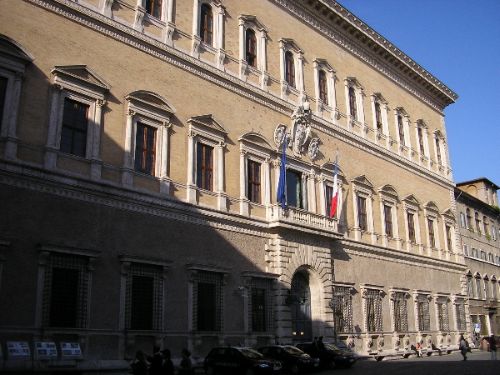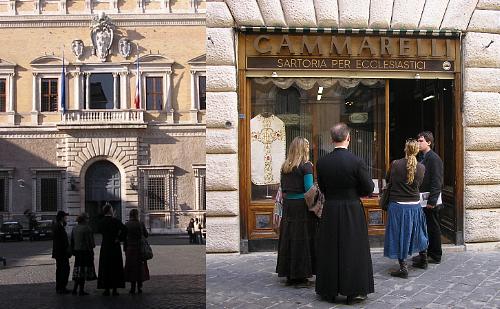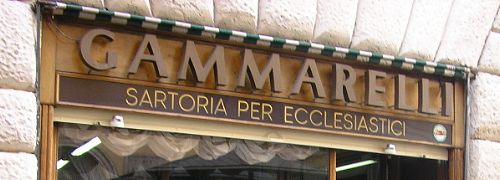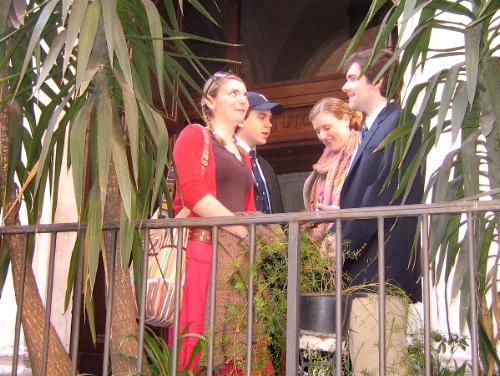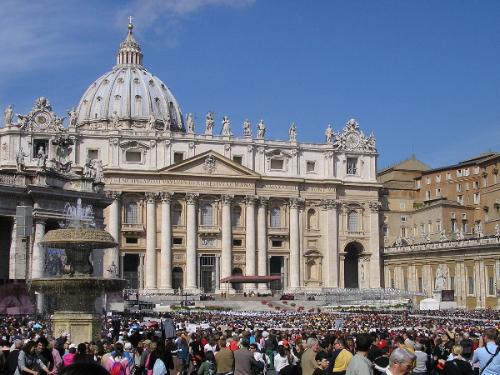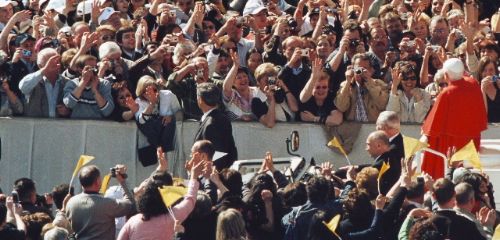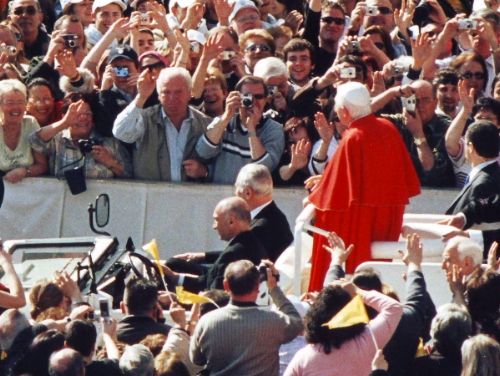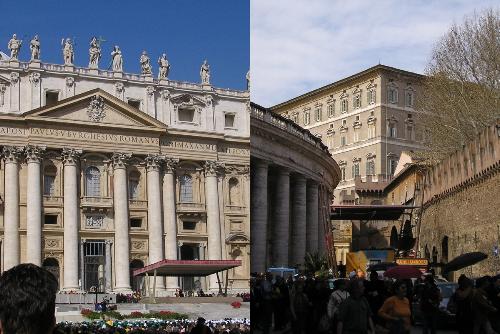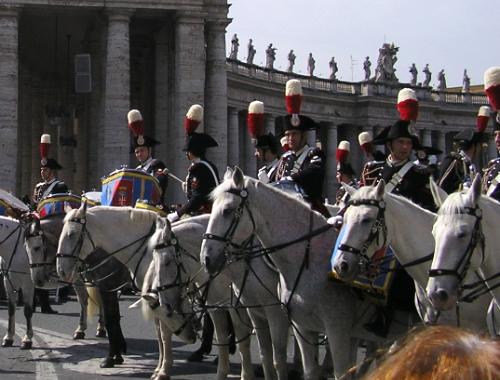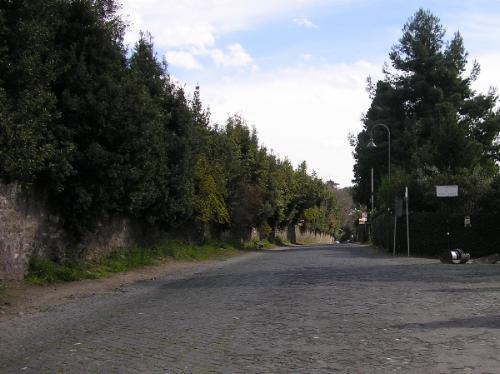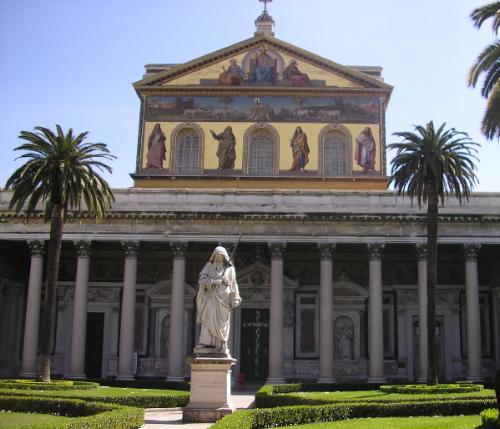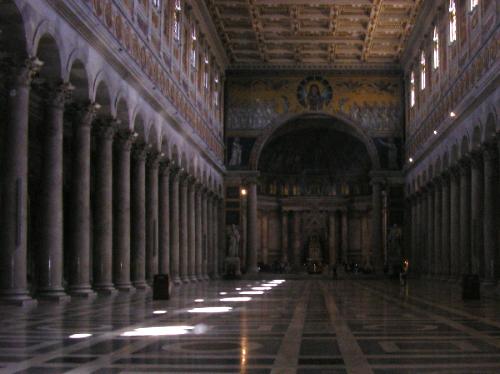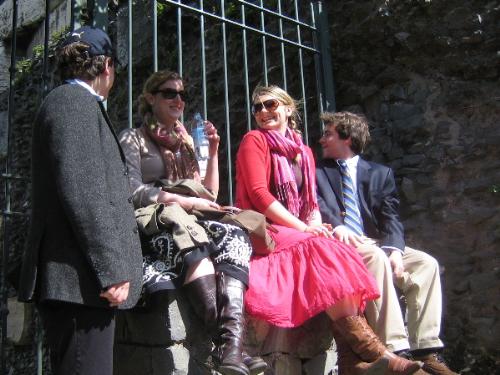CAPUT MUNDI;
Rome the head, the mind, and the capital of the world. As a great St
Andrean once put it "that most conservative of all places, Rome: Rome,
where nothing dies but of extreme caducity, where Nero's ghost,
metamorphosed to a monstrous crow, roosted on a bough for a millennium,
and where the last of the Stuarts languishes in Canova's marble under
the dome of St. Peter's." (Russell Kirk, The Conservative Mind)
Late on a Saturday afternoon, we
landed at Ciampino and I stepped out from the plane and
took my first breath of Italian air. The taxi we took from the airport
was happily emblazoned with campaign paraphernalia of Rocco
Buttiglione's party (the UDC), and the taxi driver smoked Peter
Stuyvesant cigarettes, a brand I had never heard of but was rather
appropriate as I was in the midst of Washington Irving's fanciful History
of New York part of which
relays the tales of that hard-headed great. The drive into Rome was
amazing both for its speed and the audacious maneuvering of the driver.
Though I generally have an irrational hatred of all things continental,
I must confess I've always partly admired their laissez-faire attitude
towards traffic regulations. Alas, with our larger cars in America, the
quick weaving the Italians are fond of is probably impossible.
We journeyed to the city by the Via Appia
Antica, passing along the way
the spot where Our Lord appeared to St. Peter, famously provoking the
question "Domine, Quo Vadis?", inspiring Peter's return to Rome and his
ultimate martyrdom and glorification. The ruins and remnants along the
Appian Way were beautiful in the setting sun of the early evening.
We arrived at the little convent of Santa
Guliana where we were
staying, lodged midway between the Piazza Navona and Sant'Andrea della
Valle, and one of my first impressions, gazing out the open window once
we settled ourselves in our rooms, was that Rome reminded me somewhat
of Argentina, though of course much older, and I dare say perhaps even
prettier than Buenos Aires.
After our first Italian dinner in a little
place Father knew of, we
walked back to the convent and Louise retired for the evening while
Jon, Abby, Father, and myself decided to walk to St. Peter's to pay a
nighttime visit. For Abigail and me, it was our first time in Rome and
thus our first visit to the Piazza San Pietro. We crossed the Tiber on
the Ponte Sant'Angelo and saw for the first time the brilliantly
illuminated dome of the basilica, then proceeded down the Via della
Conciliazione to the Piazza itself.
One often hears that things always seem larger
in photographs or on television
than in reality. For
example, I have often heard that the Oval Office is actually quite
smaller in real life than one would think from television and such. St.
Peter's is the exact opposite. It feels immense, huge, but without
being overbearing. Bernini's flanking colonnades create a warm though
formal embrace, drawing you in and impressing upon you both the
importance of the place and the fact that you belong there. From above,
the outline of the piazza and basilica form the shape of a keyhole, and
one can easily see this as the keyhole to the Universe, remembering
Christ's endowment of authority to His Church, that whatsoever is bound
here is bound in Heaven.
It was nearly eleven, and we saw the lights in
the Pope's apartment in
the Apostolic Palace go out, and we decided to withdraw for the
evening. Jon and I dropped Abby off at our place and decided we wanted
a cheeky drink before our convent's midnight curfew. Despite warnings
of being overpriced (and it was) we went to a place on the Piazza
Navona and enjoyed a carafe of the house red, a few cigarettes, and
some good chat before calling it a night. Whilst enjoying our wine on
the Piazza Navona, we remembered that the clocks were changing that
night, so Jon and I thought ourselves clever by changing our watches
then and there.
We were quite irate, then, when Abigail
knocked on our door to wake us
up at 6.15 in the morning, two hours before the arranged time. We
scolded her for her impudence, whereupon she informed us that it was
actually 8.15. Jon and I had both put our clocks back an hour instead
of forward. Nonetheless, we still had a little time before the Mass we
were to attend, so after breakfast in the nunnery we went to see the
Pantheon. A magnificent place, again so much larger in life than one
would imagine. It is the only major pagan temple which has survived
intact. Legend has it that when the Barbarians were sacking Rome they
roughed up whatever they could, but when the entered the Pantheon they
were astounded by its majesty and let it be. Now, of course, it is a
church, dedicated (appropriately) to All the Saints, and contains the
tombs of King Victor Emmanuel II (the 'Father of the Country' who was
made the first king of the united Italy in the 19th century) and King
Umberto I, with his wife, Queen Margherita (after whom the Margherita
pizza is named). The tombs had a Guard of Honour until Italy became a
republic in 1946, and since that time a vigil has been maintained by
volunteers from a number of Italian monarchist organisations.
We then went off to Sunday Mass at the
charming little hidden-away
chapel reserved for the use of the FSSP, which sits at the end of an
alleyway off the Piazza Nicosia. As we neared the end of the alleyway
we could hear the incantations of a Kyrie Eleison and eventually saw
that three priests were practicing their chants for the Mass. Seeing
Jon and myself as we were about to enter the Chapel, an American accent
expressed delight and asked Jon and I if we could serve the old rite.
Embarrassingly, we admitted we could not and apologized, but I don't
know why they even wanted us because when the mass did start, the
sanctuary was more crowded than Grand Central with a priest, deacon,
subdeacon, and a liberal dose of altar servers. It was an excellent
mass, especially the singing, but we had to leave after communion so we
could make it to St. Peter's Square for the Pope's Sunday Angelus.
We got to the Piazza in time and saw the tiny
white
figure of the Pope
appear at his window in the Apostolic Palace at midday, guarded from
the rays of the sun by an awning, which unfortunately made him a little
harder to see. He gave his message in Italian and then we all prayed
the Angelus with him in Latin. He then gave a brief note of welcome in
French, then spoke briefly to us in English, followed by a greeting to
the Germanophones in his native tongue, then in Spanish, and he began
to speak in Polish as we left the Piazza to seek food. Luncheon al
fresco at a little place in the Borgo. Rigatoni alla amatriciana. Good
food and good chat but often disturbed by irritating little gypsies and
gypsy children. Rome is unfortunately plagued by thousands of
thieves/beggars (they are usually the same people), but luckily none of
us suffered any pickpocketing or such.
It was after luncheon that we went and entered
the Basilica itself for
the first time. What an amazing space! I was somewhat irritated by all
the other people there, some pilgrims like us, but a great many
tourists too, looking silly and presumably lacking any appreciation for
what they were visiting. How brilliant it would be to have the whole
place to one's self for an hour or so.
Explored. Gazed. Prayers at the statue of
Saint Andrew under the dome.
Visited the Stuart monument and paid my respects there. Many prayers
for friends and family, especially my little nephew who had yet to be
born at the time. Laid into the floor of the basilica are the lengths
of other prominent churches throughout the world. I took photos of the
markers for Westminster Cathedral, my own mother church of St.
Patrick in New York, and our national church, the 'Sanctuary of the
Immaculate Conception' in Washington. Went to confession (one of the
requirements of the plenary indulgence for a pilgrimage to Rome) and
then headed back to Santa Guliana for a spot of reading and a little
siesta, and then the four of us had dinner afterwards.
MONDAY we had to wake early, for Father was
going to say mass in a
chapel in the crypt of Saint Peter's Basilica at 7:00 am. It was before
dawn as we made our way to St. Peter's, crossing the Ponte Sant'Angelo,
arriving in the Square and seeing that the Holy Father was already
awake, the lights on in the Papal Apartments. The Basilica was shrouded
in mist so from afar all you could see was the illuminated circle
around the bottom of the dome, shining like a crown. After Father
vested in the Sacristy, we made our way down into the crypt. Passing
down a corridor we came upon a gang of piously silent pilgrims, praying
and gazing at a tomb, which we then realised was that of our late Holy
Father, John Paul II. We each made a reverential bow as we passed. The
mass
was in the Hungarian chapel, which was a bit modern but nonetheless
suited out needs. Hearing mass on our knees on a stone floor underneath
St. Peter's was a special privilege during this penitential Lenten
season.
Afterwards we had breakfast, cappuccino and
croissant, in a little
snack bar on the Piazza Risorgimento (which I decided, when the
counterrevolution comes, to rename the Piazza de Maistre, or maybe the
Piazza Metternich). Then we decided to take care of some of the
basilicas we wanted to visit to fulfill the requirements for the
plenary indulgence. We took the subway to Termini from whence we walked
to the Basilica of Santa Maria Maggiore. I headed straight for the tomb
of St. Pius V, which I had written an essay on for my Art and Piety in
Western Europe class last year. Then across the nave to the altar of
Santa Maria Salus Populi Romani where Blessed Pope Pius XII said his
first mass. Mary, the 'Health of the Roman People' is the Protector of
Rome, and I made sure to say a few prayers for the safekeeping of the
holy city and the safety and freedom of the Pope and the Church.
We then proceeded to the nearby basilica of
Santa Prassede, which has
some amazingly ancient mosaics and the Pillar of the Scourging,
traditionally held to be the pillar upon which Our Lord was scourged
during His Passion. There are also some ancient sarcophagi in the crypt
which you can descend into and visit. We then walked to the Lateran
basilica of St. John. St. John's is the Cathedral of Rome and thus is
home to the throne (cathedra) of the Bishop of Rome, the Pope. After
exploring the beautiful cathedral, we had a tour of the Vatican
Historical Museum in the adjacent Lateran palace. Unfortunately half of
the Museum was closed off temporarily but we did get to see some of the
splendid rooms and the actual Lateran Treaty between the Pope and the
Kingdom of Italy which established the recognition of the Vatican as
free and independent of the Italian state. It was negotiated and agreed
to after over fifty years of enmity between the Pope and the Italian
state, which had been born when the masonic liberal nationalists such
as Garibaldi and Cavour invaded the Papal States, making the Pope a
prisoner of the Vatican. The signatures on the Lateran treaty include
our blessed Eugenio Pacelli, later Pope Pius XII, who signed it for the
Vatican as Pius XI's Secretary of State, and Benito Mussolini, who
signed it on behalf of the Kingdom of Italy as its Prime Minister.
After the museum we had lunch in a trattoria, and enjoyed good food and
good conversation as we waited for the Scala Sancta across from the
Lateran to reopen at 3 o'clock.
The Scala Sancta (or Scala Santa in Italian)
was quite possibly the
best and most rewarding part of our pilgrimage. The 'Holy Stairs' are
the steps from the Praetorium of Pontius Pilate in Jerusalem upon which
Our Lord walked to be questioned by Pilate during His Passion.
"Veritas? Quid est veritas?" Saint Helena, the British mother of the
Emperor Constantine, brought the stairs to Rome from Jerusalem around
326. The twenty-eight marble steps are ascended on your knees, saying
prayers on each step as you ascend. (Traditionally an Our Father, a
Hail Mary, and a Glory Be). Mercifully the marble stairs are covered in
wood which, though ancient and hardened, are a little easier on the
knees than solid rock. I got stuck behind an ancient Italian lady,
which at first I found irritating but learnt the value of since it made
sure I paced myself rather than rushing through it.
Twenty-eight steps. Twenty-eight times praying
to God the Father.
Twenty-eight invocations asking the Blessed Virgin to pray for us.
Twenty-eight times glorifying the Holy Trinity as your knees crumble on
the ancient steps recalling Our Lord's suffering and the idiotic things
we do when we forget to constantly remember His sacrifice. It was an
absolutely amazing experience and remarkably rewarding. Any Christian
who finds himself in Rome and does not take the opportunity of doing it
at least once in his lifetime is a fool.
Afterwards we took a slow route home, visiting
the Basilica of San
Clemente, currently under the care of the Irish Dominicans, passing the
Colosseum, the Arch of Constantine, and the Senate. We went past the
Roman Priory of the Order of Malta, which Father visited during his own
time, and passed the wretched Vittoriano, the white marble monument to
Victor Emmanuel. Its construction between 1895 and 1911
destroyed a great part of the Capitoline Hill and many medieval and
ancient buildings. It contains a giant statue of the King, as well as
the 'Altar of the Nation' and the Tomb of the Unknown Soldier. The
Romans scornfully refer to it as 'the wedding cake' or 'the typewriter'.
But after that we went through the Piazza
Venezia and down the street,
peeking into the Palace of the Doria-Pamphilj family. It was not open
to the public at that moment, but the Prince's Jack Russell Terriers
came to the door to wish us well. There we bid adieu to Father for the
day, heading back to the convent for a siesta. We dinned in the Campo
de Fiore that evening, then sauntered a little in the Piazza Navona
before heading home.
TUESDAY we saw a great variety of sites
after hearing mass in the morning. First we took a gander at the
massive Palazzo Borghese and had a wander in the little market
held in the adjacent plaza. Fr. Emerson caught a glimpse of Princess
Alessandra ('Ale') Borghese, who lives in the Palazzo and happens to be
a very good friend of our current pontiff, Pope Benedict. We then
sauntered down the Via dei Condotti, a fashionable street for shopping
and such which also happens to be home to one of the Order of Malta's
two palaces in Rome. It contains the residence of the Prince and Grand
Master of the Order ('Guardian of the Poor of Jesus Christ') and the
Magisterial library, and other governmental offices of the uniquely
sovereign order. At the end of the Condotti, of course, are the famous
Spanish Steps. The steps are so-called due to the presence of the
Kingdom of Spain's embassy to the Holy See on the Piazza di Spagna from
which the steps ascend towards the Trinità dei Monti church at
the
summit. Then we continued to the famous Trevi fountain, which despite
being
popular with tourists, I rather enjoyed. The fountain is certainly very
beautiful and despite basically encompassing and dominating the entire
square in which it is located, doesn't seem overbearing. The obligatory
tossing of a coin over the shoulder was, of course, done.
Afterwards, we marched up the Quirinal Hill to
the eponymous palace
which sits atop it. The Quirinale
was built in 1573 by Pope Gregory XIII and was the papal summer
residence until 1871 when it was usurped by the liberal nationalist
Kingdom of Italy proclaimed ten years before which took Rome from the
Vicars of Christ the previous year. With the abolition of the monarchy
in 1946, it became the official residence of the President of the
Italian Republic. Being the state residence, uninvited guests are not
allowed inside, but we admired the exterior of the Palace (designed by
Domenico Fontana, also responsible for the façade of the Lateran
basilica) and took in the superb view of Rome from the hilltop.
Nearby, we visited Bernini's superb church
dedicated to my patron
saint, Sant'Andrea al Quirinale, which contains a monument to Victor
Emmanuel I, King of Sardinia and Duke of Savoy, Piedmont, and Aosta.
From 1819 until his death in 1824, Victor was the pretender of the
Stuart succession, and thus to Jacobites he was King of England,
Scotland, and Ireland. Just down the street, we examined the Church of
San Carlo allo Quatro Fontane, designed by Bernini's less-talented
arch-rival Francesco Borromini.
WEDNESDAY is of course the day of the Pope's
weekly General Audience.
Stopped at Sant'Eustachio for a cappuccino and croissant before heading
right for Saint Peter's Square. Fr. Emerson arranged the tickets and
was told it was advisable to arrive an hour before the start of the
audience. We arrived an hour and a half before the audience and the
square was already nearly full. During the previous papacy, John Paul
II went to the world, but these days the world is coming to Rome to see
Benedict, as his weekly audiences have maintained unprecedented high
numbers of attendance for an unprecedented length of time after his
election. Luckily we managed to get a place right next to a pathway in
a section that was fairly empty when we arrived. The main section was
already full up, but within ten minutes of choosing our position our
own part was becoming pretty packed.
A little past the appointed hour, a few Swiss
Guards emerged from the
central portal of the Basilica, followed by a number of cardinals. A
little later, a wave of applause erupted throughout the Piazza, and we
saw from the large screens erected there, Benedict, riding in an
open-top white vehicle. The car circled the crowd and it was then the
Holy Father passed us by, and I remembered that poem 'Easter Day' by
Oscar Wilde:
The silver trumpets rang across the
Dome:
The people knelt upon the
ground with awe:
And borne upon the necks
of men I saw,
Like some great God, the
Holy Lord of Rome.
Priest-like, he wore a
robe more white than foam,
And, king-like, swathed
himself in royal red,
Three crowns of gold rose
high upon his head:
In splendour and in light
the Pope passed home.
My heart stole back
across wide wastes of years
To One who wandered by a
lonely sea,
And sought in vain for
any place of rest:
"Foxes have holes, and
every bird its nest.
I, only I, must wander
wearily,
And bruise my feet, and
drink wine salt with tears."
Once he was seated, we retreated to the shade
of Bernini's colonnade
and watched the proceedings from the large television screens which,
despite their convenience, rather mar the Piazza. After the General
Audience, the mounted band of the Italian Carabinieri gave a little
performance in the Piazza San Pietro, probably right on the Italian
side of the border with the Vatican. They played a few martial tunes
which I enjoyed, and after a little while we went and had a brief lunch
(only just under an hour, terse by Roman standards) for we wanted to
see the Catacombs in the afternoon.
We went, by subway and bus, to the Via Appia
Antica, which was simply
stunning. Most of it is protected as a regional park, and thus we were
surrounded by ancient looking farmhouses, a few ruins, but mostly
rustic hills and greenery. We slowly but surely made our way to the
Basilica of San Sebastiano, which we examined before heading to a tour
of the Catacombs located underneath. To see the Catacombs you must be
with a tour guide, and ours was terrible, but the Catacombs themselves
still managed to impress. The narrow passageways with graves varying
from simple slots in the earth to elaborate mausoleums were certainly
worth seeing, and travelling through it had quite the air of Indiana
Jones. Jocularity aside, who knows how many early saints were buried
there?
We then tried to make our way back into the
city by a different route
than we had arrived by, and seeing at a bus stop a young man perhaps
only a few years older than we are, Father asked him a question in
English. "How did you know I was English?" he jokingly replied,
red-haired and donning a tweed jacket. Eventually we sorted ourselves
out for a bus and heard mass at the FSSP chapel at 6.30 in the evening.
Dinner for the second time at a little place we rather enjoyed in the
Campo de Fiore.
THURSDAY happened to be my birthday, and we
began with mass in the
Chamber of Saint Catherine at the Basilica of Santa Maria Sopra
Minerva. This is the room in which Saint Catherine of Siena died, which
was transported to Rome and installed in the sacristy of the basilica.
After mass we poked around Santa Maria Sopra Minerva for a bit and then
visited a few of the neighbouring shops. I popped into a place called
Briscoli (I think) which exhibited some of the decorations (as in
orders) they manufacture. There were a good few of the Order of the
Holy Sepulchre (of which our own Professor Haldane is a knight), as
well as a few cloaks of the Constantinian Order waiting to be picked up.
Then we went to the last of the four major
basilicas we had to visit,
Saint Paul Outside the Walls, which as its name implies is located a
little distance outside the main part of the city of Rome. In addition
to being a major basilica, St. Paul's is a Benedictine abbey which
burnt down in the 19th century and was rebuilt pretty much exactly as
it had been before. It is the largest of the major basilicas after St.
Peter's. In the transepts of the basilica are two altars of striking
green marble which were donated by Czar Nicholas I of Russia. A group
of Russian Orthodox pilgrims were there, and an attendant allowed them
to venerate the relics of Saint Paul kept at the high altar, after
which they sung one of those beautiful rhythmic hymns the Russian
church is known for.
After that, we took the subway to San Pietro
and had an excellent lunch
at another little place in the Borgo, after which we examined the
Vatican bookshop and the Ancorra bookshop nearby. I nearly bought an
amply-illustrated hardcover edition of Bruno Heim's magnum opus at the
Vatican bookshop, but they only had it in Italian so I relented.
But of course it was my birthday, and to
celebrate we headed to the
rooftop terrace of the Residenza Paolo VI, overlooking St. Peter's
Square and the Vatican. Abby, Jon, Louise, Father, and I were joined by
Guy Stair Sainty, the Vice Grand Chancellor of the Constantinian Order
(amongst other things), who was quite an affable fellow, very
entertaining. We had run into him in the Piazza where Father (a
Constantinian himself) recognised him as he was heading to the Vatican
bookshop himself to pick up the new Annuario Pontificio. Mr. Sainty has
just finished editing Burke's Peerage & Gentry's World Orders of
Knighthood & Merit (which will be printed in July of this year,
2,100 pages in two volumes, full colour, for £249.95). Anyhow, he
joined us for a little while in celebrating my birthday with a few
glasses of champagne. After Mr. Sainty had left, we were joined by
Clare Dempsey, who was also in Rome at the time, along with our mutual
friend Caroline who was with her. As the afternoon/evening progressed,
it got a bit chilly on the terrace and we retreated to the dining room
for a little supper
FRIDAY was, of course, our last day in
Rome and we rose early in the morning so we could be first on line to
get into the Vatican Museum, thus avoiding waiting hours for admission.
Shortly after our arrival at the still-closed entrance we were joined
by two American airmen stationed in the Azores with whom we spoke for a
while, waiting for the museum to open. The Musei Vaticani are
extensive and
very wide-ranging, naturally, and thus it would be impossible for me to
mention all the various works we saw. Seeing the Sistine Chapel was
brilliant, excepting that it was full of chattering tourists. The real
way to experience any chapel or church is to hear mass said there, but
of course this was not possible.
What was really rather amazing was after we
had visited as much of the
museum as we felt possible we met Fr. Allen Duston, O.P., an old friend
of Fr. Emerson's and currently in charge of worldwide fundraising for
the Vatican Museums. We were met in the museum by his secretary, a
young half-Italian, half-American woman with a degree in Fine Arts from
N.Y.U. (if I recall correctly). She lead us out of the Museum, past
security guards and through various courtyards and portals to Fr.
Duston's office in the Apostolic Palace. His office was actually built
as a library by Pope Innocent X and is a spacious room lined with
wooden panelling, topped by a vaulted ceiling. Not bad at all, as
offices go, and in the Apostolic Palace to boot!
While we were waiting for Fr. Duston who was
in a meeting at the time,
we chatted with his secretary who (much to my national pride) told us
that "99.999%" of the funds raised for the Vatican museums come from
the United States. A little while later Fr. Duston arrived, clad in the
white habit of the Domincan order. The six of us then headed out to a
nice restaurant in the Borgo for lunch.
While Louise headed off to catch a tour of the
Coliseum, the rest of us
had a relaxed afternoon siesta before heading to the F.S.S.P. chapel at
5:30 for mass. After mass, Jon and Abby (who are engaged) went off to
have a proverbial romantic dinner for two on their last night in the
Eternal City, while I joined Fr. Emerson and Fr. Robert Fromageot, one
of the Fraternity's priests in Rome and a fellow New Yorker, for dinner
at the same lovely little trattoria in which we dined on our first
night in Rome. Fr. Fromageot, the son of a French father and a Cuban
concert painist mother, struck me as eminently sound and endowed with a
great deal of common sense, traits which, I'm saddened to say,
sometimes seem rare amongst traditionalists. I'm glad, however, that
the best virtues of the people of the Empire State are well-represented
by this young priest of the F.S.S.P.
ALL
IN ALL, one felt the entire pilgrimage was a great privilege. Here we
were in the center of it all, Roma, Caput Mundi,
and in the Lenten season as well. It was an amazing experience which
augmented and deepened our Lenten season. Each of us would like to
extend our immense thanks to Mr. Dudley Heathcote, KM who through his
generosity and sense of Christian charity enabled the pilgrimage to
take place, and also to the
anonymous donor who made an extra contribution towards our pilgrimage.
Many prayers for they and their families. They have made sure our
pilgrimage to the Eternal City was one which will be everlasting in our
hearts and minds, and marked upon our souls. Deo gratias!


 ANDREW
CUSACK
ANDREW
CUSACK
